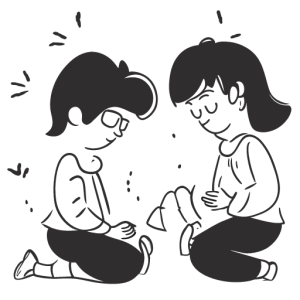Over the past decade as a trauma-informed counsellor and social worker, I have had the privilege of utilizing the Trauma Ally Framework®, an initiative by the Kyokan Foundation. This comprehensive model blends trauma-informed psychology, expressive arts, and indigenous cultural teachings, providing a holistic approach to healing for both adults and children. In this blog, I will guide you through each step of the framework, showcasing its profound impact through reflections and experiences.
Step 1: Defining Safety – Acknowledging the Roots of Trauma
Our healing journey begins with establishing a fundamental sense of safety, essential for clients embarking on their recovery path. Techniques such as gentle movements and stretches are employed to stabilize emotional states. Psychoeducation about trauma and its effects is critical, utilizing visual aids to explain the nervous system’s responses to threats. Integrating movement-based exercises from the Expressive Therapy Continuum, including bilateral stimulation, helps clients to express their emotions non-verbally, fostering a deeper connection to their feelings in a nurturing environment.
Step 2: Approaching Awareness – Healing Frameworks
In this stage, clients begin to recognize and accept their trauma symptoms through structured self-assessment tools and reflective dialogues. We utilize art-based interventions, such as working with sand trays and clay, combined with journals and guided imagery. These tools enable individuals to explore and accept their emotional landscapes, promoting a deep, non-judgmental awareness and understanding of their experiences.
Step 3: Growing Compassion – Continuing Healing Frameworks
Developing self-compassion is crucial for clients who struggle with excessive self-criticism. Expressive arts facilitate the extension of empathy and compassion towards oneself. This stage often marks a significant therapeutic shift as creative activities help emotional expressions and insights to surface and evolve.
Step 4: Developing Body Connection – Nervous System Awareness
We incorporate dance movement therapy, yoga, and drumming to enhance bodily awareness, crucial for clients who have experienced physical trauma or disassociation. These methods enable clients to safely experience and integrate their bodily sensations, promoting healing and reconnection between body and mind.
Step 5: Creating Presence – Building Strengths
Daily mindfulness exercises and guided meditations establish a routine of emotional regulation. Tailoring various meditation approaches to individual needs enhances focus and assists clients in better managing stress. This stage also introduces storytelling, writing, and poetry as therapeutic tools. These expressive writing practices allow clients to articulate their feelings and experiences creatively, providing a powerful outlet for processing and understanding their trauma narratives.
Step 6: Integrating Experiences – Somatic Connection
Clients engage with their traumatic memories, supported by their personal anchors and resources. The expressive arts, now including storytelling and creative writing, offer a means for clients to rethink and articulate their stories. This often leads to significant therapeutic breakthroughs, allowing for a richer, more coherent understanding of their personal journeys.
Step 7: Building Relationships – Relational Healing
Group therapy sessions and community arts projects encourage the development of social skills and community involvement. This stage emphasizes the importance of supportive relationships in the healing process, allowing clients to practice and experience healthy relational dynamics. Indigenous community knowledge, emphasizing communal understanding and support, is integral to this phase.
Step 8: Advancing Self-Regulation through Co-Regulation
The final steps focus on resilience training and lifelong learning. Engaging with nature provides a therapeutic backdrop that enhances the healing process, promoting long-term stability and fulfillment. Here, we continue to use storytelling and writing as tools for self-expression and community connection, reinforcing the therapeutic benefits of shared narratives and collective healing.
This holistic approach does more than address trauma symptoms; it empowers individuals to reclaim their lives and futures. The Trauma Ally Framework ® offers a roadmap that honours both individual and community strengths, making it an ideal model for practitioners seeking a comprehensive and culturally enriched approach to trauma-informed care.







